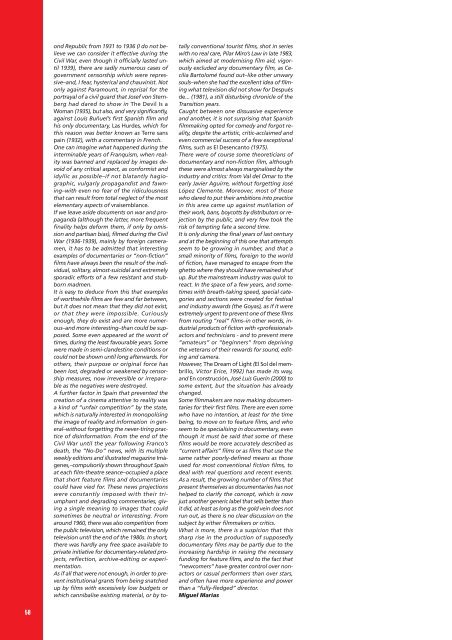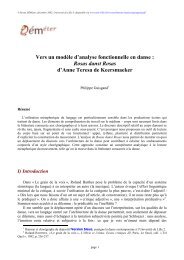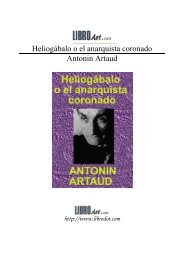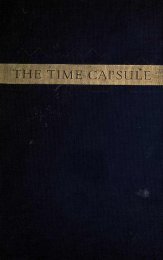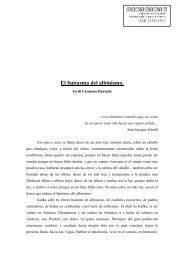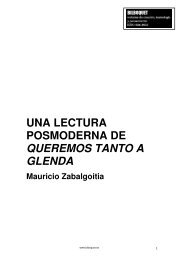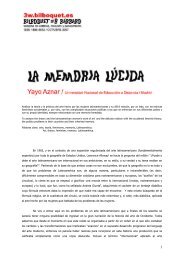07 cata 05 corr-v5 - bilboquet
07 cata 05 corr-v5 - bilboquet
07 cata 05 corr-v5 - bilboquet
- No tags were found...
Create successful ePaper yourself
Turn your PDF publications into a flip-book with our unique Google optimized e-Paper software.
ond Republic from 1931 to 1936 (I do not believewe can consider it effective during theCivil War, even though it officially lasted until1939), there are sadly numerous cases ofgovernment censorship which were repressive–and,I fear, hysterical and chauvinist. Notonly against Paramount, in reprisal for theportrayal of a civil guard that Josef von Sternberghad dared to show in The Devil Is aWoman (1935), but also, and very significantly,against Louis Buñuel’s first Spanish film andhis only documentary, Las Hurdes, which forthis reason was better known as Terre sanspain (1932), with a commentary in French.One can imagine what happened during theinterminable years of Franquism, when realitywas banned and replaced by images devoidof any critical aspect, as conformist andidyllic as possible–if not blatantly hagiographic,vulgarly propagandist and fawning–witheven no fear of the ridiculousnessthat can result from total neglect of the mostelementary aspects of vraisemblance.If we leave aside documents on war and propaganda(although the latter, more frequentfinality helps deform them, if only by omissionand partisan bias), filmed during the CivilWar (1936-1939), mainly by foreign cameramen,it has to be admitted that interestingexamples of documentaries or “non-fiction”films have always been the result of the individual,solitary, almost-suicidal and extremelysporadic efforts of a few resistant and stubbornmadmen.It is easy to deduce from this that examplesof worthwhile films are few and far between,but it does not mean that they did not exist,or that they were impossible. Curiouslyenough, they do exist and are more numerous–andmore interesting–than could be supposed.Some even appeared at the worst oftimes, during the least favourable years. Somewere made in semi-clandestine conditions orcould not be shown until long afterwards. Forothers, their purpose or original force hasbeen lost, degraded or weakened by censorshipmeasures, now irreversible or irreparableas the negatives were destroyed.A further factor in Spain that prevented thecreation of a cinema attentive to reality wasa kind of “unfair competition” by the state,which is naturally interested in monopolisingthe image of reality and information in general–withoutforgetting the never-tiring practiceof disinformation. From the end of theCivil War until the year following Franco’sdeath, the “No-Do” news, with its multipleweekly editions and illustrated magazine Imágenes,–compulsorilyshown throughout Spainat each film-theatre seance–occupied a placethat short feature films and documentariescould have vied for. These news projectionswere constantly imposed with their triumphantand degrading commentaries, givinga single meaning to images that couldsometimes be neutral or interesting. Fromaround 1960, there was also competition fromthe public television, which remained the onlytelevision until the end of the 1980s. In short,there was hardly any free space available toprivate initiative for documentary-related projects,reflection, archive-editing or experimentation.As if all that were not enough, in order to preventinstitutional grants from being snatchedup by films with excessively low budgets orwhich cannibalise existing material, or by totallyconventional tourist films, shot in serieswith no real care, Pilar Miro’s Law in late 1983,which aimed at modernising film aid, vigorouslyexcluded any documentary film, as CeciliaBartolomé found out–like other unwarysouls–when she had the excellent idea of filmingwhat television did not show for Despuésde... (1981), a still disturbing chronicle of theTransition years.Caught between one dissuasive experienceand another, it is not surprising that Spanishfilmmaking opted for comedy and forgot reality,despite the artistic, critic-acclaimed andeven commercial success of a few exceptionalfilms, such as El Desencanto (1975).There were of course some theoreticians ofdocumentary and non-fiction film, althoughthese were almost always marginalised by theindustry and critics: from Val del Omar to theearly Javier Aguirre, without forgetting JoséLópez Clemente. Moreover, most of thosewho dared to put their ambitions into practicein this area came up against mutilation oftheir work, bans, boycotts by distributors or rejectionby the public, and very few took therisk of tempting fate a second time.It is only during the final years of last centuryand at the beginning of this one that attemptsseem to be growing in number, and that asmall minority of films, foreign to the worldof fiction, have managed to escape from theghetto where they should have remained shutup. But the mainstream industry was quick toreact. In the space of a few years, and sometimeswith breath-taking speed, special categoriesand sections were created for festivaland industry awards (the Goyas), as if it wereextremely urgent to prevent one of these filmsfrom routing “real” films–in other words, industrialproducts of fiction with «professional»actors and technicians - and to prevent mere“amateurs” or “beginners” from deprivingthe veterans of their rewards for sound, editingand camera.However, The Dream of Light (El Sol del membrillo,Víctor Erice, 1992) has made its way,and En construcción, José Luis Guerín (2000) tosome extent, but the situation has alreadychanged.Some filmmakers are now making documentariesfor their first films. There are even somewho have no intention, at least for the timebeing, to move on to feature films, and whoseem to be specialising in documentary, eventhough it must be said that some of thesefilms would be more accurately described as“current affairs” films or as films that use thesame rather poorly-defined means as thoseused for most conventional fiction films, todeal with real questions and recent events.As a result, the growing number of films thatpresent themselves as documentaries has nothelped to clarify the concept, which is nowjust another generic label that sells better thanit did, at least as long as the gold vein does notrun out, as there is no clear discussion on thesubject by either filmmakers or critics.What is more, there is a suspicion that thissharp rise in the production of supposedlydocumentary films may be partly due to theincreasing hardship in raising the necessaryfunding for feature films, and to the fact that“newcomers” have greater control over nonactorsor casual performers than over stars,and often have more experience and powerthan a “fully-fledged” director.Miguel Marías58


